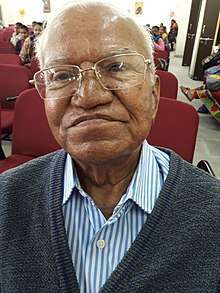Mukund Parikh
| Mukund Parikh | |
|---|---|
 At government college, Kathlal, January 2018 | |
| Born |
Mukund Bhailal Parikh 26 January 1934 Nadisar, Panchmahal district, Gujarat, India |
| Occupation | Poet, novelist, playwright |
| Language | Gujarati |
| Nationality | Indian |
| Education | B.A, LL.B |
| Alma mater | Gujarat University |
| Period | modern Gujarati literature |
| Literary movement | Re Math, Akanth Sabarmati |
| Notable works | Mahabhinishkraman (1968) |
Mukund Parikh is a Gujarati novelist, poet and playwright from Gujarat, India.
Life
Mukund Parikh was born on 26 January 1934 in Nadisar village (now in Panchmahal district, Gujarat) to Bhailal Parikh. He completed his primary and secondary education from his native town Balasinor. He completed his B. A. in Economics from Dharmendrasinhji College, Rajkot in 1957. He worked in a Provident Fund Commissioner Office from 1954 to 1980. He studied LL.B. from Ahmedabad in 1980 from Gujarat University.[1] Since 1981, he is working as a lawyer.[2]
Works
His Mahabhinishkraman (1968) was an experimental novel.[3][4] The story follows a love triangle of a character named Amit Dalal and it explores his relationship with three ladies: Chandan, his mother; Rama, his wife and Saroj, his lover. Parikh employs the stream of consciousness in his narration. He has used motifs such as pipal tree and darkness. He has explored Oedipus complex in his character's relationships. The novel was particularly praised for its language.[2][5]
He was associated with the experimental literary circles such as Re Math and Akanth Sabarmati. His one-act play Choras Inda Ane Gol Kabaro was included in a collection of five one-act plays Make Believe (1968) published by Re Math. This play is considered as an example of an absurd play from the early period of modern Gujarati literature. It is a psychological play flipping the places of an actor and the viewers in the theatre. Moksh (1975) is his one-act plays collection.[2]
Man Chitarie (2004) is his poetry collection awarded by Gujarat Sahitya Akademi.[2]
He co-edited poetry journal Shabda with Ravji Patel.[6]
See also
References
- ↑ Narasimhiah Seshagiri (2008). Encyclopaedia of Cities and Towns in India: Gujarat. Gyan Publishing House. p. 96. ISBN 978-81-212-0981-6.
- 1 2 3 4 Brahmabhatt, Prasad (2010). અર્વાચીન ગુજરાતી સાહિત્યનો ઈતિહાસ - આધુનિક અને અનુઆધુનિક યુગ [History of Modern Gujarati Literature – Modern and Postmodern Era] (in Gujarati). Ahmedabad: Parshwa Publication. pp. 196–198. ISBN 978-93-5108-247-7.
- ↑ K. M. George (1992). Modern Indian Literature, an Anthology: Surveys and poems. Sahitya Akademi. p. 141. ISBN 978-81-7201-324-0.
- ↑ The Illustrated Weekly of India. 101. Times of India. 1980.
- ↑ Gujarat. Smt. Hiralaxmi Navanitbhai Shah Dhanya Gurjari Kendra, Gujarat Vishvakosh Trust. 2007. p. 404.
- ↑ Indian Literature. Sahitya Akademi. January 2009. p. 263. Retrieved 31 January 2017.